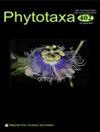New records of Pestalotioid species associated with leaf spot disease on Camellia sinensis from northern Thailand
IF 1
4区 生物学
Q3 PLANT SCIENCES
引用次数: 0
Abstract
Camellia sinensis (L.) Kuntze var. assamica (Miang tea) is widely distributed in northern Thailand due to its traditional and industrial attributes, including black tea and Miang production. In this study, two Pestalotioid taxa associated with C. sinensis leaf spots were collected in Mae Taeng district, Chiang Mai Province, Thailand. Species delineation was based on the evidence from morphological and multi-locus phylogenies using ITS, tub2 and tef1-α. Neopestalotiopsis saprophytica is herein reported as a new record on Camellia sinensis, while Pseudopestalotiopsis chinensis is recorded as a new geographical record from Thailand. The findings of this research have the potential to offer fresh insights into the two previously documented species within the existing fungal community associated with C. sinensis in Thailand. This, in turn, could enhance our comprehension of their interactions with the host plant in the times ahead.泰国北部与山茶叶斑病有关的 Pestalotioid 物种的新记录
山茶(Camellia sinensis (L.) Kuntze var. assamica)(湄茶)因其传统和工业属性(包括红茶和湄茶生产)而广泛分布于泰国北部。本研究在泰国清迈府湄登县采集了两个与中华茶树叶斑病相关的 Pestalotio 类群。物种划分基于形态学证据以及使用 ITS、tub2 和 tef1-α 进行的多焦点系统进化。本报告中的 Neopestalotiopsis saprophytica 是茶树上的新记录,而 Pseudopestalotiopsis chinensis 则是泰国的新地理记录。这项研究的结果有可能使人们对泰国现有的与中华茶树相关的真菌群落中的两个先前记录的物种有新的认识。这反过来又能加深我们对它们与寄主植物之间相互作用的理解。
本文章由计算机程序翻译,如有差异,请以英文原文为准。
求助全文
约1分钟内获得全文
求助全文
来源期刊

Phytotaxa
PLANT SCIENCES-
CiteScore
1.90
自引率
27.30%
发文量
956
审稿时长
1 months
期刊介绍:
Phytotaxa is a peer-reviewed, international journal for rapid publication of high quality papers on any aspect of systematic and taxonomic botany, with a preference for large taxonomic works such as monographs, floras, revisions and evolutionary studies and descriptions of new taxa. Phytotaxa covers all groups covered by the International Code of Nomenclature foralgae, fungi, and plants ICNafp (fungi, lichens, algae, diatoms, mosses, liverworts, hornworts, and vascular plants), both living and fossil. Phytotaxa was founded in 2009 as botanical sister journal to Zootaxa. It has a large editorial board, who are running this journal on a voluntary basis, and it is published by Magnolia Press (Auckland , New Zealand). It is also indexed by SCIE, JCR and Biosis.
All types of taxonomic, floristic and phytogeographic papers are considered, including theoretical papers and methodology, systematics and phylogeny, monographs, revisions and reviews, catalogues, biographies and bibliographies, history of botanical explorations, identification guides, floras, analyses of characters, phylogenetic studies and phytogeography, descriptions of taxa, typification and nomenclatural papers. Monographs and other long manuscripts (of 60 printed pages or more) can be published as books, which will receive an ISBN number as well as being part of the Phytotaxa series.
 求助内容:
求助内容: 应助结果提醒方式:
应助结果提醒方式:


